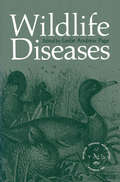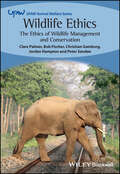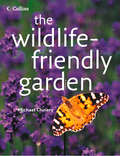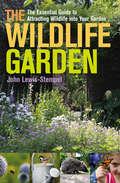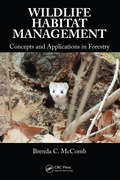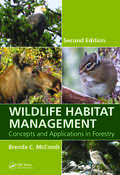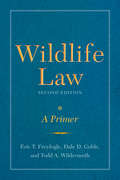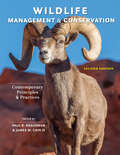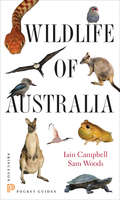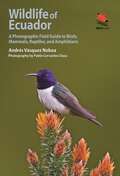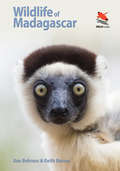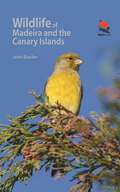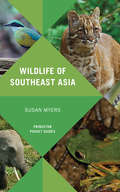- Table View
- List View
Wildlife Diseases
by Leslie PageThe broad spectrum of topics covered in the nine symposia and four open-paper sessions of the Third Inter national Wildlife Disease Conference comprise a remarkable collection of ideas and current research information on diseases of wildlife. The term "wildlife" is broad in itself and is interpreted by the Conference sponsor, The Wildlife Disease Association, to mean all free-living vertebrate and invertebrate members of the animal kingdom. The Conference's invitational symposia brought to Munich an array of wildlife specialists from around the world who addressed major problems affecting the under standing and control of diseases of wildlife. The open paper sessions attracted many well-known scientists with detailed data from their specialized studies. Over 100 participants were present to hear 84 scientific papers. The Wildlife Disease Association and the Conference editors, through their publisher, are pleased to offer this compilation of presentations as a Conference Pro ceedings. This volume will be an important data source for the study of diseases of wildlife by students, specialists, and general biologists everywhere. WDA President W. G. Winkler expresses the Associa tion's gratitude to the Conference Chairman, Prof. Dr. H.
Wildlife Ethics: The Ethics of Wildlife Management and Conservation (UFAW Animal Welfare)
by Clare Palmer Bob Fischer Christian Gamborg Jordan Hampton Peter SandoeWildlife Ethics A systematic account of the ethical issues related to wildlife management and conservation Wildlife Ethics is the first systematic, book-length discussion of the ethics of wildlife conservation and management, and examines the key ethical questions and controversies. Tackling both theory and practice, the text is divided into two parts. The first describes key concepts, ethical theories, and management models relating to wildlife; the second puts these concepts, theories, and models to work, illustrating their significance through detailed case studies on controversies in wildlife management and conservation. The book explores pressing topics including human responsibilities due to climate change, tradeoffs when managing zoonotic disease risks, the ethics of the wildlife trade, culling non-native species, indigenous wildlife use, and zoo-based conservation programs. Readers are encouraged to explore different ways of valuing wild animals and their practical implications. This essential text: Explains and explores relationships between valuing biodiversity, human utility, ecosystems, species, and animal welfare Describes established approaches to wildlife management, such as sustainable use, and emerging concepts, such as compassionate conservation Discusses key ethical theories, including utilitarianism, ecocentrism, and animal rights Offers a practical model of how to analyze ethical issues in wildlife management and conservation Wildlife Ethics: The Ethics of Wildlife Management and Conservation is an accessible introduction to complex ethical issues, making the book an important resource for students in fields such as conservation biology, ecology, environmental science and policy, game management, public health and veterinary medicine. It will also be an invaluable tool for wildlife managers, conservationists, One Health practitioners, practicing veterinarians and animal rehabilitation staff, contemporary wildlife professionals and other stakeholders.
Wildlife Ethics: The Ethics of Wildlife Management and Conservation (UFAW Animal Welfare)
by Clare Palmer Bob Fischer Christian Gamborg Jordan Hampton Peter SandoeWildlife Ethics A systematic account of the ethical issues related to wildlife management and conservation Wildlife Ethics is the first systematic, book-length discussion of the ethics of wildlife conservation and management, and examines the key ethical questions and controversies. Tackling both theory and practice, the text is divided into two parts. The first describes key concepts, ethical theories, and management models relating to wildlife; the second puts these concepts, theories, and models to work, illustrating their significance through detailed case studies on controversies in wildlife management and conservation. The book explores pressing topics including human responsibilities due to climate change, tradeoffs when managing zoonotic disease risks, the ethics of the wildlife trade, culling non-native species, indigenous wildlife use, and zoo-based conservation programs. Readers are encouraged to explore different ways of valuing wild animals and their practical implications. This essential text: Explains and explores relationships between valuing biodiversity, human utility, ecosystems, species, and animal welfare Describes established approaches to wildlife management, such as sustainable use, and emerging concepts, such as compassionate conservation Discusses key ethical theories, including utilitarianism, ecocentrism, and animal rights Offers a practical model of how to analyze ethical issues in wildlife management and conservation Wildlife Ethics: The Ethics of Wildlife Management and Conservation is an accessible introduction to complex ethical issues, making the book an important resource for students in fields such as conservation biology, ecology, environmental science and policy, game management, public health and veterinary medicine. It will also be an invaluable tool for wildlife managers, conservationists, One Health practitioners, practicing veterinarians and animal rehabilitation staff, contemporary wildlife professionals and other stakeholders.
Wildlife Forensic Investigation: Principles and Practice
by John E. Cooper Margaret E. CooperWildlife forensics is the application of forensic science to the conservation and protection of non-domesticated animals, both in the wild and in captivity. Providing an in-depth introduction to this rapidly evolving field, Wildlife Forensic Investigation: Principles and Practice also chronicles aspects of the history of management, conservation, a
The Wildlife-friendly Garden
by Michael ChineryFull of helpful expert advice and many practical projects, this ebook edition of the successful hardback is a fascinating illustrated guide to encouraging wildlife into your garden, whether you live in the town or the country.
The Wildlife Garden
by John Lewis-StempelWith the erosion of native wildlife habitats, gardens increasingly provide an invaluable source of food and shelter for Britain's fauna and flora. The Wildlife Garden is the essential guide to attracting birds to your bushes, butterflies to your buddleia and a whole array of other creatures into your garden - even if you only have a window box. Whether you just want to make an existing family space more wildlife friendly or go the whole hedgehog and turn your back garden into a mini nature reserve The Wildlife Garden will show you how to do it. There is full information on what plants are best for wildlife, on how to make refuges for insects and homes for bats, on making a pool for frogs, all whilst adding scent and colour to your surroundings.
A Wildlife Guide to Chile: Continental Chile, Chilean Antarctica, Easter Island, Juan Fernández Archipelago
by Sharon ChesterThis is the first comprehensive English-language field guide to the wildlife of Chile and its territories--Chilean Antarctica, Easter Island, Juan Fernández, and San Félix y San Ambrosio. From bats to butterflies, lizards to llamas, and ferns to flamingos, A Wildlife Guide to Chile covers the country's common plants and animals. The color plates depict species in their natural environments with unmatched vividness and realism. The combination of detailed illustrations and engaging, succinct, and authoritative text make field identification quick, easy, and accurate. Maps, charts, and diagrams provide information about landforms, submarine topography, marine environment, climate, vegetation zones, and the best places to view wildlife. This is an essential guide to Chile's remarkable biodiversity. The only comprehensive English-language guide to Chile's common flora and fauna The first guide to cover Chile and its territories--Chilean Antarctica, Easter Island, Juan Fernández, and San Félix y San Ambrosio 120 full-color plates allow quick identification of more than 800 species Accompanying text describes species size, shape, color, habitat, and range Descriptions list size, distribution, and English, Spanish, and scientific names Information on the best spots to view wildlife, including major national parks Compact and lightweight--a perfect field guide
A Wildlife Guide to Chile: Continental Chile, Chilean Antarctica, Easter Island, Juan Fernández Archipelago (PDF)
by Sharon ChesterThis is the first comprehensive English-language field guide to the wildlife of Chile and its territories--Chilean Antarctica, Easter Island, Juan Fernández, and San Félix y San Ambrosio. From bats to butterflies, lizards to llamas, and ferns to flamingos, A Wildlife Guide to Chile covers the country's common plants and animals. The color plates depict species in their natural environments with unmatched vividness and realism. The combination of detailed illustrations and engaging, succinct, and authoritative text make field identification quick, easy, and accurate. Maps, charts, and diagrams provide information about landforms, submarine topography, marine environment, climate, vegetation zones, and the best places to view wildlife. This is an essential guide to Chile's remarkable biodiversity. The only comprehensive English-language guide to Chile's common flora and fauna The first guide to cover Chile and its territories--Chilean Antarctica, Easter Island, Juan Fernández, and San Félix y San Ambrosio 120 full-color plates allow quick identification of more than 800 species Accompanying text describes species size, shape, color, habitat, and range Descriptions list size, distribution, and English, Spanish, and scientific names Information on the best spots to view wildlife, including major national parks Compact and lightweight--a perfect field guide
Wildlife Habitat Management
by Brenda C. McCombIn recent years, conflicts between ecological conservation and economic growth forced a reassessment of the motivations and goals of wildlife and forestry management. Focus shifted from game and commodity management to biodiversity conservation and ecological forestry. Previously separate fields such as forestry, biology, botany, and zoology merged
Wildlife Habitat Management: Concepts and Applications in Forestry, Second Edition
by Brenda C. McCombShortlisted for the 2018 TWS Wildlife Publication Awards in the authored book categoryIn recent years, conflicts between ecological conservation and economic growth forced a reassessment of the motivations and goals of wildlife and forestry management. Focus shifted from game and commodity management to biodiversity conservation and ecological fore
Wildlife Habitat Management: Concepts and Applications in Forestry, Second Edition
by Brenda C. McCombShortlisted for the 2018 TWS Wildlife Publication Awards in the authored book categoryIn recent years, conflicts between ecological conservation and economic growth forced a reassessment of the motivations and goals of wildlife and forestry management. Focus shifted from game and commodity management to biodiversity conservation and ecological fore
Wildlife Heroes: 40 Leading Conservationists and the Animals They Are Committed to Saving
by Julie Scardina Jeff FlockenWith one-third of known species being threatened with extinction, wildlife conservationists are some of the most important heroes on the planet, and Wildlife Heroes profiles the work of 40 of the leading conservationists and the animals and causes they are committed to saving, such as Belinda Low (zebras), Iain Douglas-Hamilton (elephants), Karen Eckert (sea turtles), S.T. Wong (sun bear), Steve Galster (wildlife trade), and Wangari Maathai (habitat loss). Since we all should have an interest in conservation, there is a chapter providing information on ways people can get involved and make a difference. Chapter introductions are by author Kuki Gallmann, actor Ted Danson, actress Stefanie Powers, Congressman Jay Inslee, and TV personality Jack Hanna.
Wildlife Jack: I Want To Fly
by Ed KellieProduction company Moon Studio has launched a new children's series called WILDLIFE JACK AND HIS ANIMAL ADVENTURES on the Disney channel this summer, narrated by Chris Packham. It is a new wildlife TV show aimed at 2-6 year olds.
Wildlife Law: A Primer
by Eric T. Freyfogle Dale D. Goble Todd A. WildermuthTen years ago, Wildlife Law: A Primer was the first‑ever published survey of wildlife law for lay readers. Since its publication, the legal terrain has increased in complexity and the stakes are higher than ever. As humans encroach further into wildlife habitat, unwanted human‑wildlife interactions are occurring more frequently, sometimes with alarming and tragic outcomes. This revised and expanded second edition retains basic legal concepts from the first edition while offering new chapters that cover new controversial topics such as private wildlife reserves, game ranches, and nuisance species. It also includes expanded coverage of the Endangered Species Act. This is a groundbreaking reference for students in wildlife programs, land owners, and wildlife professionals.
Wildlife Management and Conservation: Contemporary Principles and Practices
by Paul R. Krausman And James W. Cain IIIThe definitive textbook for students of wildlife management, now updated to cover the latest techniques, tools, and topics.Wildlife Management and Conservation presents a clear overview of the management and conservation of animals, their habitats, and how people influence both. The relationship among these three components of wildlife management is explained in chapters written by leading experts and is designed to prepare students for careers in which they will be charged with maintaining healthy animal populations. To be successful wildlife professionals, they will need to find ways to restore depleted populations, reduce overabundant, introduced, or pest species, and manage relationships among various human stakeholders. This book gives them the basic knowledge necessary to accomplish these goals.This second edition, which is updated throughout, features several new and expanded topics, including communication in the wildlife profession, fire science, Indigenous models of management and conservation, plant–animal interactions, quantitative analysis of wildlife populations, and a detailed glossary. The book also covers:• Human dimensions of wildlife management• Animal behavior• Predator–prey relationships• Structured decision making• Issues of scale in wildlife management• Wildlife health• Historical context of wildlife management and conservation• Hunting and trapping• Nongame species• Nutrition ecology• Water management• Climate change• Conservation planningThe most widely used foundational text in the field, this is the perfect resource not only for students but also for early career professionals and those in related fields who need to understand the core tenets and tools of wildlife conservation and management.Contributors: C. Jane Anderson, Bart M. Ballard, Warren B. Ballard, John A. Bissonette, Clint Boal, Scott B. Boyle, Leonard A. Brennan, Robert D. Brown, James W. Cain III, Tyler A. Campbell, Michael J. Cherry, Michael R. Conover, Daniel J. Decker, Randall W. DeYoung, Jonathan B. Dinkins, W. Sue Fairbanks, Selma N. Glasscock, James B. Grand, Michael J. Haney, James R. Heffelfinger, Scott E. Henke, Fidel Hernandez, Davie G. Hewitt, C. L. Hoving, David A. Jessup, Heather E. Johnson, Winifred B. Kessler, John L. Koprowski, Paul R. Krausman, William P. Kuvlesky, Jr., Roel R. Lopez, R. W. Mannan, Scott Mills, Michael S. Mitchell, Michael L. Morrison, Anna M. Muñoz, John F. Organ, Katherine L. Parker, William F. Porter, Shawn J. Riley, Steven S. Rosenstock, Michael C. Runge, Susan P. Rupp, William F. Siemer, Robert J. Steidl, Kelley M. Stewart
Wildlife Management and Conservation: Contemporary Principles and Practices
by Paul R. Krausman James W. CainThe definitive textbook for students of wildlife management, now updated to cover the latest techniques, tools, and topics.Wildlife Management and Conservation presents a clear overview of the management and conservation of animals, their habitats, and how people influence both. The relationship among these three components of wildlife management is explained in chapters written by leading experts and is designed to prepare students for careers in which they will be charged with maintaining healthy animal populations. To be successful wildlife professionals, they will need to find ways to restore depleted populations, reduce overabundant, introduced, or pest species, and manage relationships among various human stakeholders. This book gives them the basic knowledge necessary to accomplish these goals.This second edition, which is updated throughout, features several new and expanded topics, including communication in the wildlife profession, fire science, Indigenous models of management and conservation, plant–animal interactions, quantitative analysis of wildlife populations, and a detailed glossary. The book also covers:• Human dimensions of wildlife management• Animal behavior• Predator–prey relationships• Structured decision making• Issues of scale in wildlife management• Wildlife health• Historical context of wildlife management and conservation• Hunting and trapping• Nongame species• Nutrition ecology• Water management• Climate change• Conservation planningThe most widely used foundational text in the field, this is the perfect resource not only for students but also for early career professionals and those in related fields who need to understand the core tenets and tools of wildlife conservation and management.Contributors: C. Jane Anderson, Bart M. Ballard, Warren B. Ballard, John A. Bissonette, Clint Boal, Scott B. Boyle, Leonard A. Brennan, Robert D. Brown, James W. Cain III, Tyler A. Campbell, Michael J. Cherry, Michael R. Conover, Daniel J. Decker, Randall W. DeYoung, Jonathan B. Dinkins, W. Sue Fairbanks, Selma N. Glasscock, James B. Grand, Michael J. Haney, James R. Heffelfinger, Scott E. Henke, Fidel Hernandez, Davie G. Hewitt, C. L. Hoving, David A. Jessup, Heather E. Johnson, Winifred B. Kessler, John L. Koprowski, Paul R. Krausman, William P. Kuvlesky, Jr., Roel R. Lopez, R. W. Mannan, Scott Mills, Michael S. Mitchell, Michael L. Morrison, Anna M. Muñoz, John F. Organ, Katherine L. Parker, William F. Porter, Shawn J. Riley, Steven S. Rosenstock, Michael C. Runge, Susan P. Rupp, William F. Siemer, Robert J. Steidl, Kelley M. Stewart
Wildlife Medicine and Rehabilitation: Self-Assessment Color Review
by Anna Meredith Emma KeebleVeterinarians increasingly encounter wildlife casualties in practice and have a duty of care for the welfare of the animals. This comprehensive and easy-to-use self assessment book contains some 208 clinical cases with 325 illustrations. It has been compiled by authors with a wide range of experience and expertise in this area. Common conditions se
Wildlife Medicine and Rehabilitation: Self-Assessment Color Review
by Anna Meredith Emma KeebleVeterinarians increasingly encounter wildlife casualties in practice and have a duty of care for the welfare of the animals. This comprehensive and easy-to-use self assessment book contains some 208 clinical cases with 325 illustrations. It has been compiled by authors with a wide range of experience and expertise in this area. Common conditions se
Wildlife of Australia
by Iain Campbell Sam WoodsIdeal for the nature-loving traveler, Wildlife of Australia is a handy photographic pocket guide to the most widely seen birds, mammals, reptiles, amphibians, and habitats of Australia. The guide features more than 400 stunning color photographs, and coverage includes 350 birds, 70 mammals, 30 reptiles, and 16 frogs likely to be encountered in Australia's major tourist destinations. Accessible species accounts are useful for both general travelers and serious naturalists, and the invaluable habitat section describes the Australian bush and its specific wildlife. Animal species with similar features are placed on the same plates in order to aid identification. Wildlife of Australia is an indispensable and thorough resource for any nature enthusiast interested in this remarkable continent. Easy-to-use pocket guide More than 400 high-quality photographs Accessible text aids identification Habitat guide describes the Australian bush and its specific wildlife Coverage includes the 350 birds, 70 mammals, 30 reptiles, and 16 frogs most likely to be seen on a trip around Australia
Wildlife of Ecuador: A Photographic Field Guide to Birds, Mammals, Reptiles, and Amphibians
by Andrés Vásquez Noboa Pablo Cervantes DazaMainland Ecuador's spectacular wildlife makes it a magnet for nature tourists, but until now there hasn't been a go-to, all-in-one guide geared to the general reader. With this handy and accessible guide, visitors now have everything they need to identify and enjoy the majority of birds and animals they are likely to see. Written and illustrated by two of Ecuador's most experienced nature guides and photographers, this book covers more than 350 birds, mammals, amphibians, and reptiles. It features over 400 stunning color photographs and includes a range map for each species, as well as a brief account of the country's natural history and biogeography. With its extensive coverage, attractive and easy-to-use layout, beautiful photographs, and nontechnical text, this is an essential guide for anyone who wants to explore the natural wonders of Ecuador.An essential all-in-one guide to mainland Ecuador's amazing wildlifeUnique and attractive layout with more than 400 stunning color photographsCovers more than 350 of the most frequently seen birds, mammals, reptiles, and amphibiansUses a habitat-based approach to aid identificationAccessible text provides key information on identification, behavior, biology, and conservationPhotos, maps, and text are presented together for ease of use
Wildlife of Madagascar
by Ken Behrens Keith BarnesThe Indian Ocean island of Madagascar is one of the world's great natural treasures and ecotourism destinations. Despite being an island, it is home to nearly an entire continent’s variety of species, from the famous lemurs to a profusion of bizarre and beautiful birds, reptiles and amphibians. Wildlife of Madagascar is a compact and beautifully illustrated photographic guide, and an essential companion for any visitor or resident. With an eye-catching design, authoritative and accessible text and easy-to-use format, it provides information on identification, distribution, habitat, behaviour, biology and conservation for all the mammals, birds, reptiles, amphibians and butterflies likely to be seen. The most comprehensive single-volume field guide to Madagascar’s wildlife Attractive layout features more than 900 stunning colour photographs Covers the mammals, birds, reptiles, amphibians and butterflies, and some of the other invertebrates and plants, most likely to be seen Provides key information about identification, distribution, habitat, behaviour and conservation Introductory sections provide background information on Madagascar and its unique environments
Wildlife of Madeira and the Canary Islands: A Photographic Field Guide to Birds, Mammals, Reptiles, Amphibians, Butterflies and Dragonflies (Wildlife Explorer Guides)
by John BowlerThis beautifully illustrated photographic field guide is the first to focus on the identification of the fascinating, diverse and unique wildlife of Madeira and the Canary Islands--featuring the birds, mammals, reptiles, amphibians, butterflies and dragonflies that are most likely to be seen. Richly illustrated introductory sections cover the key wildlife sites to visit on each of the islands and provide an overview of the islands' geography, climate, habitat types and current conservation efforts. Stunning colour photographs highlight the key identification features of each species, and the accompanying text covers status, habitat preference, behaviour and, where appropriate, calls. The guide also features an up-to-date distribution map for each species. Complete with an attractive, user-friendly design, this is a must-have guide for all visitors to these magical islands.A beautifully designed and illustrated photographic field guide to the wildlife of Madeira and the Canary IslandsHighlights the islands' unique native species and their conservation statusCovers all birds, land and marine mammals, reptiles, amphibians, butterflies and dragonflies that are likely to be seenFeatures richly illustrated introductory sections on key sites to visit on each of the islands, covering their geography, climate, habitats and conservationIncludes distribution maps for all species, as well as information on occurrence, status, habitat preference, behaviour and calls
Wildlife of Southeast Asia
by Susan MyersThis handy photographic guide offers a stunning look at the wildlife of Southeast Asia, which includes Burma, Thailand, Laos, Cambodia, Vietnam, West Malaysia, and Singapore. Accessible text and more than 500 color photographs help readers to learn about and identify the most common species found in the region, particularly the mammals, birds, reptiles, amphibians, and insects that visitors will most likely encounter. Detailed photos are accompanied on facing pages by succinct species accounts highlighting key identification features, status, and distribution. The book's brief introduction offers readers useful information on major wildlife sites as well as practical advice on making the most of a wildlife-watching trip.Wildlife of Southeast Asia is the essential resource for visitors and residents interested in the fauna of this fascinating area of the world.A photographic guide to the wildlife of Southeast Asia, including Burma, Thailand, Laos, Cambodia, Vietnam, West Malaysia, and SingaporeMore than 500 stunning color photographsAccessible species accounts highlight key identification features, status, and distributionA brief introduction discusses wildlife locations and practical travel know-how
Wildlife of Southeast Asia
by Susan MyersThis handy photographic guide offers a stunning look at the wildlife of Southeast Asia, which includes Burma, Thailand, Laos, Cambodia, Vietnam, West Malaysia, and Singapore. Accessible text and more than 500 color photographs help readers to learn about and identify the most common species found in the region, particularly the mammals, birds, reptiles, amphibians, and insects that visitors will most likely encounter. Detailed photos are accompanied on facing pages by succinct species accounts highlighting key identification features, status, and distribution. The book's brief introduction offers readers useful information on major wildlife sites as well as practical advice on making the most of a wildlife-watching trip.Wildlife of Southeast Asia is the essential resource for visitors and residents interested in the fauna of this fascinating area of the world.A photographic guide to the wildlife of Southeast Asia, including Burma, Thailand, Laos, Cambodia, Vietnam, West Malaysia, and SingaporeMore than 500 stunning color photographsAccessible species accounts highlight key identification features, status, and distributionA brief introduction discusses wildlife locations and practical travel know-how
Wildlife of Southern Africa (Traveller’s Guide)
by David Hosking Martin WithersThe perfect companion for the safari enthusiast, this complete traveller’s guide to the wildlife of Namibia, Botswana, Zimbabwe, South Africa and Malawi is a must-have for all those considering a trip to the game reserves of this highly popular region.
